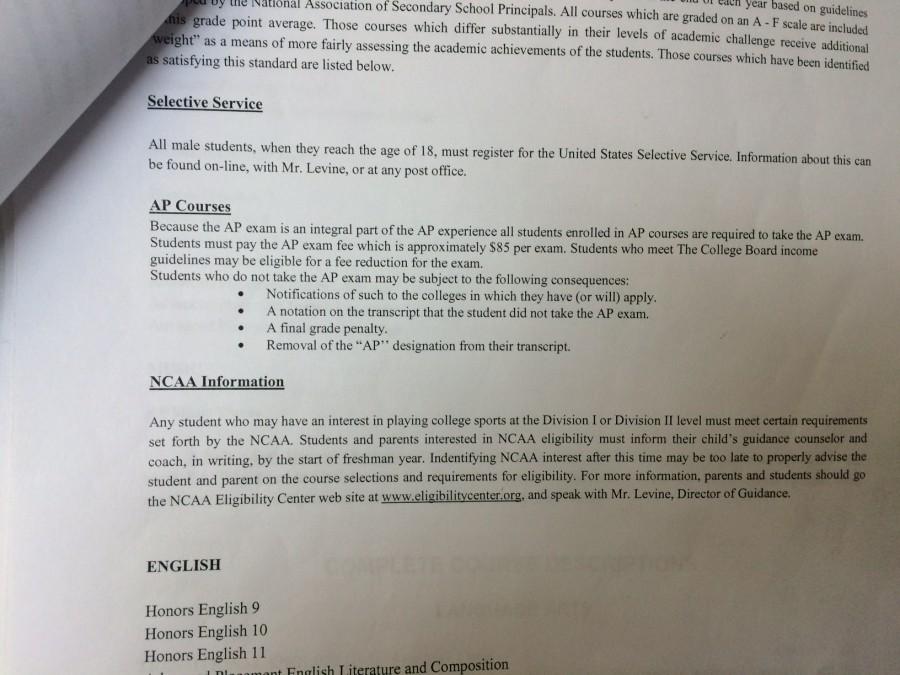AP Unrest Part II: The Cost of Being Costly
The consequences of not taking an AP exam.
My father wrote a check for $455 this year to pay for my AP exams. As absurd as that number is, it doesn’t hold a candle to the amount of money some families have dropped so their children could take the exams. Families with multiple children in these high level classes may spend upwards of 1k a year from the time the students enter AP eligibility sophomore year through senior year. AP exam costs, paired with the costs of SAT/ACT prep and actual exams, contribute to the growing frustration regarding the bill of higher education.
Seniors Helene and Audrey Rowland are enrolled in a combined total of nine AP courses, bringing their family’s bill to $819 this year alone: between the three Rowland girls and all of their AP exams, the Rowland family has spent $1,820, possibly $1,911 if Helene tacks on another exam in May. Other families like the Flanagans, the Ciriellos, and the Hurleys also suffer the pain of having to pay x amount of money to enable their children to prove their prowess in whatever high level class they’re taking.
What is even more frustrating is that at MHS, AP exams are mandatory for all students enrolled, with no alternatives for high level classes. So for families like the Rowlands and the Ciriellos, opting out of even a few exams is not an option. For seniors, this is especially frustrating as many AP students will not be able to receive credit for many of their courses: while some schools accept scores of 4 or 5 to fulfill prerequisite courses, most of the highest-ranking schools insist on students taking their own placement exams and do not consider AP scores at all. While maintaining a strong work ethic in a rigorous course load is significant in college decisions, it is frustrating for seniors not to earn college credit for their college-level courses as well as have to pay for this higher level of education.
Upon realizing the amount the AP exams would cost her family this year, Helene Rowland began taking steps to refuse to take the exams. Citing the issue with college credit, which her older sister Lainie faced at Brown University, as well as frustration with the system as a whole, Rowland insists that the entire ordeal is wholly unfair. “We’re being made to pay for a higher level of education,” she notes, an idea that seems counterintuitive: shouldn’t high-achieving students be rewarded with reduced education costs? Many European university systems work as such: high-achieving students vie to attend the cheaper, government-funded public schools, their education subsidized by merit grants, whereas mediocre students are faced with high-cost private schools as a result of not earning a cheaper education. Essentially, it pays to do well in school. Rowland also cites the absurdity of the price given that MHS is a public school and the entire point of free, tax-ensured education is negated by these costs.
Because MHS is such a highly competitive school and AP credentials speak volumes to students regardless of the credit they may earn further on in their educational careers, no student has ever refused to take an AP exam. The punishments for refusing to do so are listed in the MHS Student Handbook and include a notification to the student’s potential/confirmed colleges, a notation on their transcript of failure to take the exam, a final grade penalty, and removal of the “AP” designation from their transcript. These punishments have never been enforced given the compliance of the students to take the exams. However, the only two that may have any clout on a student’s college opportunities are the notification and the removal of the AP, the latter of which would affect one’s GPA. Because AP scores are not released until July, they have no immediate impact on a student’s standing in the course and the grade penalty would be trivial. Colleges also understand the costliness of these College Board exams and why some students would not partake.
Though the cost was not the primary deterrent for Rowland’s family, it is the principle of the matter that counts. The price tag also reflects upon the struggles of some families who do want to support their children in taking higher-level courses but cannot afford it. Each public school has a state-mandated fund to subsidize the cost of the exams for less-fortunate AP students, but the MHS fund has not been touched in years and tallies in around 200$, just enough to pay for two whole exams.
What impact lies beyond the monetary cost of the AP exams? Besides barring some students from taking AP courses, it deeply segregates the wealthier students from the poorer in school districts like Morristown, Newark, North Bergen, and Piscataway, to name a few. This poses major issues for high-level schools in trying to design a diverse, high-achieving student body. It reinforces elitism. While the top-tier schools are not the only ones that provide solid higher education, it reflects down the chain: by discouraging students from pursuing challenging courses, it ingrains at a young age that there is no use in disadvantaged students trying to break down barriers, when in reality the exact opposite is the case. If AP exams continue to set such absurd barriers between students and proving their prowess in a given area, we will fail to exhibit the diversity and strength of our student body via test scores, as will schools across the nation.
